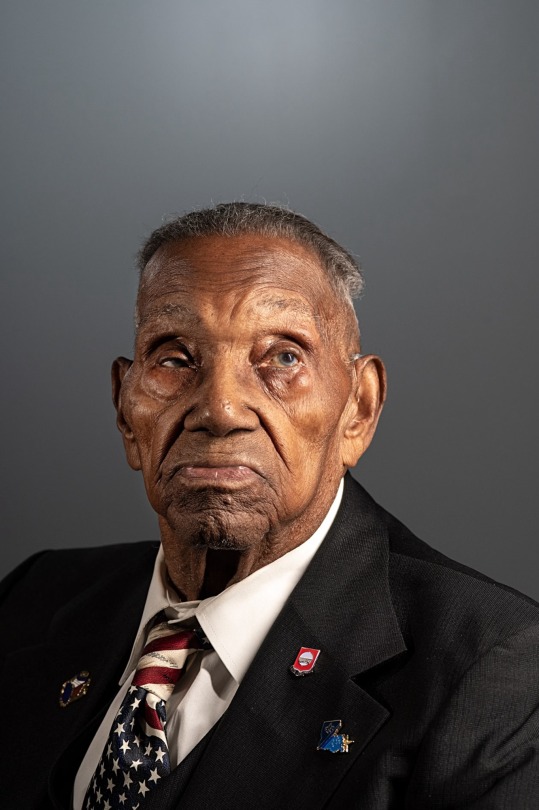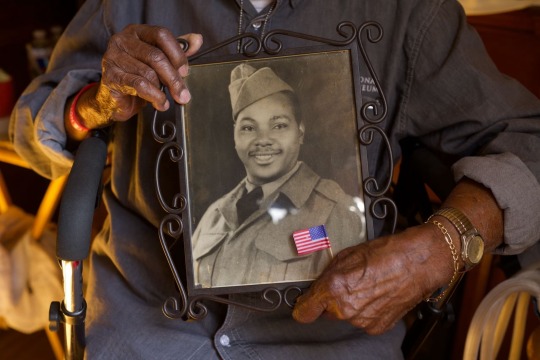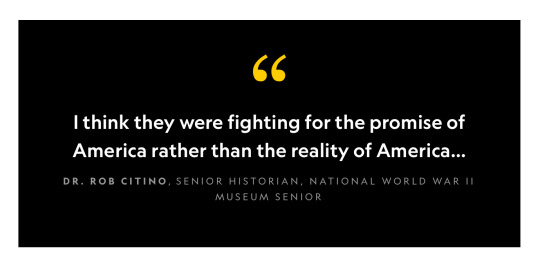#Chelsea Brasted
Explore tagged Tumblr posts
Text

At age 110, Lawrence Brooks of New Orleans is the Oldest Known Living U.S. Veteran of World War II. From 1941 to 1945 he served in the Pacific with the Army’s predominantly African American 91st Engineer Battalion, as a support worker to its officers. Of the 16 million U.S. veterans who fought in World War II, only 300,000 are still alive. He credits a healthy lifestyle, deep faith and love of people for his longevity. Photograph By Robert Clark
America’s Oldest Living WWII Veteran Faced Hostility Abroad—And At Home
At 110 Years Old, Louisiana Native Lawrence Brooks is Proud of His Service and Says he Would Do It Again.
— By Chelsea Brasted | Published: May 11, 2020 | Saturday November 11, 2023
Editor's Note: Lawrence Brooks died on January 5, 2022, at the age of 112, the National WWII Museum said in a statement.
The memories are more than 75 years old now: Cooking red beans and rice halfway around the world from the place in Louisiana that first made the recipe. Cleaning uniforms and shining shoes for three officers. Hopping in foxholes when his trained ear could tell the approaching warplanes were not American but Japanese.
The man who keeps these memories is older still. At 110, Lawrence Brooks is the oldest known U.S. veteran of World War II. This month marks the 75th anniversary of the end of the war in Europe. Of the 16 million U.S. veterans who served, about 300,000 are still alive today, according to the U.S. Department of Veterans Affairs.
Brooks is proud of his military service, even though his memories of it are complicated. Black soldiers fighting in the war could not escape the racism, discrimination, and hostility at home.

Lawrence Brooks, photographed in his home, holds a portrait of his younger self. Born September 12, 1909, Brooks was drafted into the Army at age 31. Despite the segregated army and hostile treatment he received during and after the war, Brooks is a proud veteran. After the war he worked as a forklift operator until he retired nearly 40 years ago. The national World War II Museum in New Orleans hosts a birthday party for him each year. Photograph By Robert Clark
When Brooks was stationed with the U.S. Army in Australia, he was an African-American man in a time well before the Civil Rights Movement would at least codify something like equality in his home country.
“I was treated so much better in Australia than I was by my own white people,” Brooks says. “I wondered about that. That’s what worried me so much. Why?”
Rob Citino, Senior Historian at the National World War II Museum in New Orleans, says the U.S. military then had “racist characterizations” of African-American soldiers during the war.
“You couldn’t put a gun in their hands,” he says of the then-prevalent attitude. “They could do simple menial tasks. That was the lot of the African-American soldier, sailor, airman, you name it.”
The jobs open to African-American troops depended on the branch of service and changed as the need for manpower increased throughout the long years of war.

“We went to war with Hitler, the world’s most horrible racist, and we did so with a segregated army because, despite guarantees of equal treatment, this was still Jim Crow America,” Citino says. “African Americans were still subject to all kinds of limitations and discrimination based on the color of their skin. I think they were fighting for the promise of America rather than the reality of America.”
Of the 16 million Americans who donned a military uniform, 1.2 million were African Americans who were “often being treated as second-class citizens at home,” Citino says.
To put that into perspective, Citino says, consider that German prisoners of war could have been served at restaurants while en route to or from their quarters at Camp Hearne in Texas, but the African-American soldiers who transported them would have been denied service.
Brooks says he never discussed these inequalities with his fellow African-American service members. “Every time I think about it, I’d get angry, so the best thing I’d do is just leave it go,” he says.
The military was not formally desegregated until President Harry Truman forced it with a 1948 executive order. For Brooks, who served in the Army between 1940 and 1945, that order would come too late.
A reluctant soldier, it didn’t sit right with him that he might be required to take another person’s life.
“My mother and father always raised me to love people, and I don’t care what kind of people they are,” he says. “And you mean to tell me, I get up on these people and I got to go kill them? Oh, no, I don’t know how that’s going to work out.
Raised in Norwood, Louisiana, near Baton Rouge, Brooks came from a big family of 15 children. He drew on another lesson from his mother—cooking—in his Army job, which had him assisting a few white officers, doing their cleaning and cooking. Part of the 91st Engineers Battalion in the Pacific Theater, whose responsibility was to build military infrastructure, Brooks’ unit often didn’t stay anywhere long. He’d occasionally drive the officers he served to nights out on the town when they could get away for an adventure or two. But even that job didn’t keep him from carrying a rifle everywhere he went.
“I had to keep it with me,” he says. “And I was glad I did. I didn’t want to be out there shooting at people because they’d be shooting at me, and they might have got lucky and hit.”
Brooks says he was treated “better” by white Americans when he returned from the war, but it would take nearly two decades before the Civil Rights Act was signed into law.
The father of five children, 13 grandchildren, and 22 great grandchildren, Brooks worked for many years as a forklift operator before retiring in his seventies. For years he avoided discussing his experiences in the war, sharing little of his story with his children as they grew up.
His daughter, Vanessa Brooks, who cares for him, says the first time she started hearing his stories was about five years ago when the World War II Museum began hosting annual birthday parties for him in New Orleans, where he now lives. But he still shies away from his family’s questions about his war years.
“I had some good times and I had some bad times,” Brooks says. “I just tried to put all the good ones and the bad ones together and tried to forget about all of them.”
Brooks says his military years taught him to straighten up, so he did his best to eat right and stay healthy. He never enjoyed the taste of alcohol and the way liquor burned his throat. “I don't like hurting my body,” he says.
In 2005, Brooks lost his wife, Leona, to Hurricane Katrina. She died shortly after the couple was evacuated by helicopter from their home. “Hurricane Katrina took everything I owned, washed away everything,” he said last year.
Still, Brooks is upbeat. He enjoys spending warm days on his daughter’s front porch in Central City, a neighborhood at the heart of New Orleans. It’s not uncommon to hear Mardi Gras Indians singing, or watch a brass band-led second-line parade go by on Sundays.
Brooks uses his walker to head out of his bedroom—bedecked in the black and gold colors of the New Orleans Saints—to chat with the children at the daycare next door. At 110, he says, his key to a good life is straightforward: “Serve God, and be nice to people.”
#History& Culture | WWII 75 Years Later#America’s Oldest Living WWII Veteran#112-Year-Old Lawrence Brooks#Chelsea Brasted#National Geographic#National WWII Museum
0 notes
Text
this article suggests that there is being a jazz music resurgence fuelled by gen z.
genz are getting excited and interested by more retro styles, from fashion to technology, like the return of headphones rather than airpods.
jazz is returning because people are finding the culture of new orleans more interesting which is where jazz originated.
jazz is connected to rebellion, which might be fuelling its popularity from gen z
this suggests that genz are beginning to have a bigger interest in music and exploring locations in relation to the music that originates from there, which supports the idea of Belgium&blues exploring the cities of which blues music originates from and suggests is jazz music is becoming more popular, blues music might too because it had an influence on jazz so the expectation would be that people would explore deeper and discover blues music too.
What is different about jazz and blues is that blues is more emotive and draws on experience of heartbreak and struggles, which would relate well to genz because as a generation they are more aware of emotions and mental health.
Brasted, Chelsea. “Gen Z Is Fuelling a Jazz Comeback.” Www.axios.com, 10 Jan. 2024, www.axios.com/2024/01/10/gen-z-jazz-comeback-trend. [Accessed 25 Apr. 2024]
0 notes
Photo

"A slow start the morning after a Saints loss." by BY CHELSEA BRASTED via NYT Business https://ift.tt/3xpjW4A
0 notes
Text
harry kane drakt Med laget hans som holdt fast på e
harry kane drakt Med laget hans som holdt fast på en liten ledelse med ett mål i døende øyeblikk, trengte Jose Mourinhos menn noen å ta presset av f som de så ut for å se seieren.Cue Romelu Lukaku.Spissen plukket opp ballen på egen banehalvdel og holdt unna utfordringen til N'Golo Kante, før han kjørte mot motstanderens mål.Med noen blåskjorter foran Lukaku viste stor fart og brast gjennom midten av dem da han ga seg en målmulighet. Selv om innsatsen hans ville bli blokkert, hadde belgieren
på egenhånd drevet laget sitt opp på banen, og tatt trykket av Chelsea. søkte desperat etter en utligning. Det var en utrolig innsats under alle omstendigheter, men det faktum at den kom i det 92. minutt gjør oppløpet enda mer imponerende. MOURINHOS REAKSJON SA DET ALLT Det var et fantastisk spill fra Lukaku og sjefen hans satte også pris på hans innsats, og mange la merke til at han feiret løpet som om det var et mål. Portugiseren hentydet også til løpet i intervjuet etter kampen, og
hevdet at det var et eksempel på Manchester Uniteds ønske om å vinne. Når han snakket om spissen hans sa Mourinho: " Han spilte fantastisk bra. Han hadde samme start som laget. Laget startet ikke godt eller selvsikkert, det samme var for ham. Han var litt tapt." Men så ble han med laget og han avsluttet kampen med bildet av laget som ga alt fotballdrakt barn billig for å vinne en viktig kamp for oss." døende øyeblikk, med noen som til og med hevdet at øyeblikket uttrykte forbedringen hans i en rød skjorte.
0 notes
Photo

"In New Orleans, Anxiously Watching the Levees As Hurricane Ida Arrives" by Richard Fausset, Katy Reckdahl and Chelsea Brasted via NYT U.S. https://www.nytimes.com/2021/08/29/us/hurricane-ida-new-orleans-scene.html?partner=IFTTT
0 notes
Photo

"In New Orleans, Anxiously Watching the Levees As Hurricane Ida Arrives" by Richard Fausset, Katy Reckdahl and Chelsea Brasted via NYT U.S. https://www.nytimes.com/2021/08/29/us/hurricane-ida-new-orleans-scene.html?partner=IFTTT
0 notes
Photo

"In New Orleans, Anxiously Watching the Levees As Hurricane Ida Arrives" by Richard Fausset, Katy Reckdahl and Chelsea Brasted via NYT U.S. https://www.nytimes.com/2021/08/29/us/hurricane-ida-new-orleans-scene.html?partner=IFTTT
0 notes
Photo

"In New Orleans, Anxiously Watching the Levees As Hurricane Ida Arrives" by Richard Fausset, Katy Reckdahl and Chelsea Brasted via NYT U.S. https://ift.tt/3Dnaq4N
0 notes
Photo

"In New Orleans, Anxiously Watching the Levees As Hurricane Ida Arrives" by Richard Fausset, Katy Reckdahl and Chelsea Brasted via NYT U.S. https://ift.tt/3Dnaq4N
0 notes
Photo

"In New Orleans, Anxiously Watching the Levees As Hurricane Ida Arrives" by Richard Fausset, Katy Reckdahl and Chelsea Brasted via NYT U.S. https://www.nytimes.com/2021/08/29/us/hurricane-ida-new-orleans-scene.html?partner=IFTTT
0 notes
Photo

"In New Orleans, Anxiously Watching the Levees As Hurricane Ida Arrives" by Richard Fausset, Katy Reckdahl and Chelsea Brasted via NYT U.S. https://www.nytimes.com/2021/08/29/us/hurricane-ida-new-orleans-scene.html?partner=IFTTT
0 notes
Text
In New Orleans, Anxiously Watching the Levees As Hurricane Ida Arrives

By Richard Fausset, Katy Reckdahl and Chelsea Brasted The prospect of “another Katrina” has haunted New Orleans, and the rest of the nation. Published: August 28, 2021 at 05:00PM from U.S. via New York TimesNYT
0 notes
Photo

"New Orleans residents emerge in a bruised city littered with leaves and shingles." by BY RICHARD FAUSSET AND CHELSEA BRASTED via NYT U.S. https://ift.tt/3ytjL7i
0 notes
Photo

"In New Orleans, Anxiously Watching the Levees As Hurricane Ida Arrives" by Richard Fausset, Katy Reckdahl and Chelsea Brasted via NYT U.S. https://www.nytimes.com/2021/08/29/us/hurricane-ida-new-orleans-scene.html?partner=IFTTT
0 notes
Text
In New Orleans, Anxiously Watching the Levees As Hurricane Ida Arrives

By Richard Fausset, Katy Reckdahl and Chelsea Brasted The prospect of “another Katrina” has haunted New Orleans, and the rest of the nation. Published: August 28, 2021 at 03:00PM from NYT U.S. https://www.nytimes.com/2021/08/29/us/hurricane-ida-new-orleans-scene.html?partner=IFTTT via IFTTT
0 notes
Photo

"In New Orleans, Anxiously Watching the Levees As Hurricane Ida Arrives" by Richard Fausset, Katy Reckdahl and Chelsea Brasted via NYT U.S. https://www.nytimes.com/2021/08/29/us/hurricane-ida-new-orleans-scene.html?partner=IFTTT
0 notes